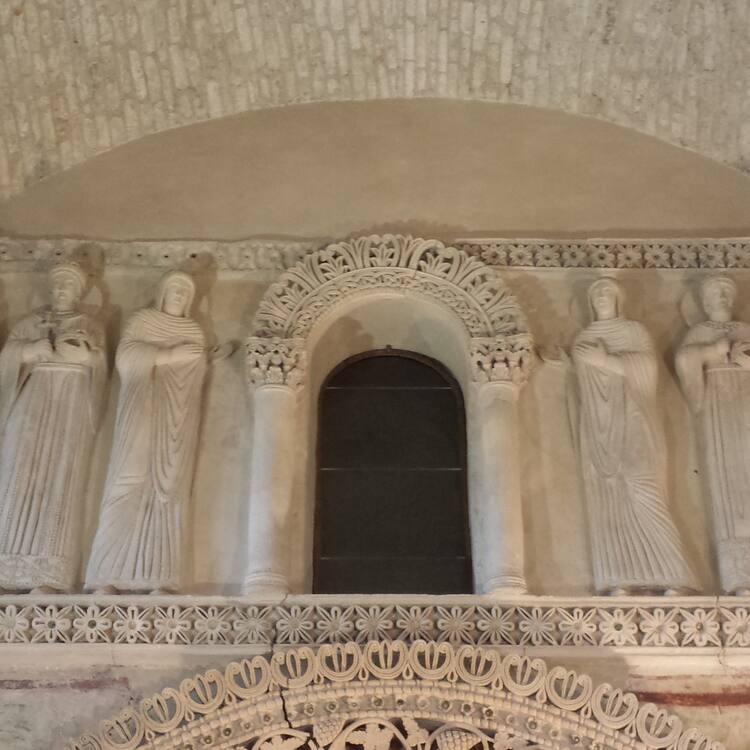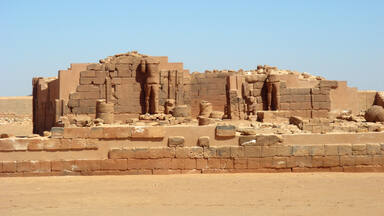Longobards in Italy. Places of the Power (568-774 A.D.)
Longobards in Italy. Places of the Power (568-774 A.D.)
The Longobards in Italy, Places of Power, 568 - 774 A.D. comprises seven groups of important buildings (including fortresses, churches, and monasteries) throughout the Italian Peninsula. They testify to the high achievement of the Lombards, who migrated from northern Europe and developed their own specific culture in Italy where they ruled over vast territories in the 6th to 8th centuries. The Lombards synthesis of architectural styles marked the transition from Antiquity to the European Middle Ages, drawing on the heritage of Ancient Rome, Christian spirituality, Byzantine influence and Germanic northern Europe. The serial property testifies to the Lombards' major role in the spiritual and cultural development of Medieval European Christianity, notably by bolstering the monastic movement.
Description is available under license CC-BY-SA IGO 3.0
Les Lombards en Italie. Lieux de pouvoir (568-774 après J.-C.)
Les Lombards en Italie, Lieux de pouvoir (568-774 apr J.-C.) comprennent sept groupes de bâtiments importants (dont des forteresses, des églises, des monastères, etc.) situés à Friuli, Brescia, Castelseprio, Spolète, Campello sul Clitunno, Bénévent, Monte Sant'Angelo. Ils témoignent des réalisations des Lombards, venus d'Europe du Nord pour s'implanter en Italie où ils ont développé une culture spécifique et dirigé de vastes territoires du VIe au VIIIe siècle. La synthèse lombarde de plusieurs styles architecturaux marque la transition entre l'Antiquité et le Moyen Age européen ; elle s'appuie sur l'héritage de l'ancienne Rome, la spiritualité chrétienne, l'influence de Byzance et de l'Europe germanique. Les sept sites témoignent du rôle important joué par les Lombards dans le développement culturel et spirituel de la Chrétienté médiévale, notamment en appuyant le mouvement monastique.
Description is available under license CC-BY-SA IGO 3.0
أمكنة اللمبارديين في إيطاليا، أماكن السلطة، 568- 774 بعد الميلاد
يضم هذا الموقع سبع مجموعات من المباني المهمة (ومنها عدد من الحصون والكنائس والأديرة، وما إلى ذلك) في فريولي، وبريسكيا، وكاستل سيبريو - توربا، وسبوليتو، وكامبيلو سول كليتونو، وبينيفنتو، ومونتي سان أنجيلو. وتشهد هذه المباني على الإنجازات الكبرى للمبارديين الذي غادروا شمال أوروبا وبنوا ثقافتهم الخاصة في إيطاليا حيث سيطروا على أراضٍ شاسعة في الفترة الممتدة من القرن السادس إلى القرن الثامن. واستخدم اللمبارديون مزيجاً من أنماط الهندسة المعمارية طبع مرحلة الانتقال من العصور القديمة إلى العصور الوسطى في أوروبا، واستوحوا من ميراث روما القديمة والروحانية المسيحية والنمط البيزنطي والهندسة المعمارية الجرمانية شمال أوروبا. ويشهد هذا الموقع المتسلسل على الدور البارز الذي أداه اللمبارديون في النهضة الروحية والثقافية لمسيحيي أوروبا في العصور الوسطى، ولاسيما دعمهم للحركة الرهبانية في المنطقة.
source: UNESCO/CPE
Description is available under license CC-BY-SA IGO 3.0
意大利伦巴第人遗址
由7组重要建筑所组成,包括城堡、教堂、修道院等,分别位于意大利的弗留利(Friuli)、布雷西亚(Brescia)、卡斯特尔赛普里欧-托尔巴(Castelseprio - Torba)、斯波莱托(Spoleto)、坎佩洛南克里通诺(Campello Sul Clitunno)、贝内文托(Benevento)以及蒙特圣安杰洛(Monte San’Angelo)等7座城市。这些建筑物代表着伦巴第人的高度成就。伦巴第人最初由北欧移居到意大利,公元6世纪至8世纪,他们曾统治过意大利的大片领土,并发展出属于自己的独特文化。伦巴第建筑结合了多种风格,吸收了古罗马、基督教、拜占庭及北欧日耳曼等多种元素和影响,标志着欧洲古代向中世纪的过渡。这一系列遗址见证了伦巴第在中世纪欧洲基督教精神与文化的发展中所起到的重要作用,特别是对修道运动所给予的推进作用。
source: UNESCO/CPE
Description is available under license CC-BY-SA IGO 3.0
Лангобарды в Италии, сосредоточия власти, 568 -774 н.э.
включает семь групп крупных сооружений (в том числе крепостей, церквей и монастырей) по всей территории Италии. Они свидетельствуют о высоком уровне развития лангобардов, которые мигрировали сюда из Северной Европы и создали свою самостоятельную культуру в Италии. С 6-го по 8-й век лангобарды управляли здесь обширными территориями. Созданный ими синтез архитектурных стилей ознаменовал переход от античности к европейскому средневековью. В нем сочетались элементы, унаследованные от Древнего Рима, заимствованные у раннего христианства, отражающие влияние Византии и германской Северной Европы. Эти памятники свидетельствуют о важной роли лангобардов в духовном и культурном развитии, становлении средневекового европейского христианства. Они сыграли эту роль, в частности, поддерживая монашеское движение.
source: UNESCO/CPE
Description is available under license CC-BY-SA IGO 3.0
Centros de poder de los longobardos en Italia –568-774 d.C
Este sitio comprende siete grupos de edificaciones importantes –fortalezas, iglesias, monasterios, etc.– situadas a lo largo de la Península Itálica. Esos edificios constituyen un testimonio de las grandes realizaciones de los lombardos, pueblo oriundo del norte de Europa que desarrolló su cultura específica en la península italiana, donde dominaron vastos territorios entre los siglos VI y VIII. La transición de la Antigüedad a la Edad Media en Europa fue marcada por la síntesis de estilos arquitectónicos efectuada por los lombardos, en la que se fusionaron el legado del antiguo Imperio Romano y la espiritualidad del cristianismo, así como influencias de Bizancio y de la Europa septentrional germánica. Los siete lugares que forman el sitio constituyen un testimonio del importante papel desempeñado por los lombardos en el desarrollo espiritual y cultural de la cristiandad medieval europea, en la que impulsaron en particular el movimiento monástico.
source: UNESCO/CPE
Description is available under license CC-BY-SA IGO 3.0
イタリアのロンゴバルド族:権勢の足跡(568-774年)
イタリア半島全土に及ぶ要塞、教会、修道院を含む7つの建築群で構成される。北欧から移住して来たロンゴバルド(ロンバルド)族が6世紀から8世紀にイタリア半島を広く統治し、独自の文化を発展させたことを証明している。その建築様式は、古代ローマの伝統、キリスト教の精神性、ビザンチン文化の影響とゲルマン系北欧様式を統合させ、古代から中世への移行期を表している。これらの遺産は、中世ヨーロッパキリスト教の精神的、文化的発展にロンゴバルド族が主要な役割を果たしたことを示している。source: NFUAJ
Longobarden in Italië. Plaatsen van macht (568 tot 774 na Christus)
Onder dit Werelderfgoed vallen zeven groepen belangrijke gebouwen (inclusief forten, kerken en kloosters) verspreid over het Italiaanse schiereiland. Ze getuigen van de grote prestaties van de Longobarden – ook wel Lombarden genoemd – die migreerden uit Noord-Europa en hun eigen specifieke cultuur ontwikkelden in Italië, waar ze regeerden over uitgestrekte gebieden van de 6e tot 8e eeuw. De synthese van architecturale stijlen van de Lombarden markeerde de overgang van de Oudheid naar de Europese Middeleeuwen. De plaatsen getuigen van de belangrijke rol die de Lombarden hadden in de geestelijke en culturele ontwikkeling van het middeleeuwse Europese christendom, met name door de versterking van de monastieke beweging.
Source: unesco.nl
Outstanding Universal Value
Brief synthesis
The serial property represents the quintessence of the remaining built and artistic heritage of the Lombards in Italy today. A people of Germanic origin, having settled and converted to Christianity, the Lombards assimilated the material and cultural values inherited from the end of the Roman world. Also in contact with Byzantine, Hellenistic and Middle Eastern influences, the Lombards achieved a cultural, architectural and artistic synthesis, unique in terms of its monumental and stylistic diversity and the various secular and religious uses. It is one of the main roots of the beginnings of the medieval European world and the establishment of Western Christianity.
Criterion (ii): The Lombard monuments are an exemplary testimony to the cultural and artistic synthesis that occurred in Italy in the 6th to the 8th centuries, between the Roman heritage, Christian spirituality, Byzantine influence and the values derived from the Germanic world. They paved the way for and heralded the flowering of Carolingian culture and artistry.
Criterion (iii): The Lombard places of the power express remarkable new artistic and monumental forms, testifying to a Lombard culture characteristic of the European High Middle Ages. It takes the form of a clearly identifiable and unique cultural ensemble, the many languages and objectives of which express the power of the Lombard elite.
Criterion (vi): The place of the Lombards and their heritage in the spiritual and cultural structures of medieval European Christianity is very important. They considerably reinforced the monastic movement and contributed to the establishment of a forerunner venue for the great pilgrimages, in Monte Sant'Angelo, with the spread of the worship of St Michael. They also played an important role in the transmission of literary, technical, architectural, scientific, historical and legal works from Antiquity to the nascent European world.
Integrity
The sites meet the conditions of integrity, in particular as regards the serial justification. The application of rigorous selection criteria has led to the exclusion of the ancient Lombard royal capitals and the imposition of strict boundaries. Nonetheless, the sites include all the elements required to express the series' Outstanding Universal Value, notably through the adequate state of conservation of its components.
Authenticity
The conditions of authenticity of the monumental, decorative and epigraphic elements presented are adequate. They are accompanied by detailed architectural, artistic, archaeological and historical documentation that justifies both their selection and their authenticity.
Protection and management requirements
All the nominated sites benefit from the highest level of legal protection, established by the Legislative Decree No 42 of 22 January 2004 (Codice dei beni culturali e del paesaggio). It is a complex property with many of its important components being intrinsically fragile and delicate to conserve, such as the archaeological remains, paintings and stucco. Nonetheless, adequate conservation measures are implemented by the State Party.
There is a specific management system for each of the seven properties, in relation to their ownership, comprising many and varied stakeholders. The Italia Langobardorum association network has become an overarching authority able to harmonise and monitor the series. The Management Plan includes a very comprehensive range of projects. Nonetheless, they need to be prioritised in terms of the lasting conservation of the properties and the environmental expression of their outstanding value. In addition to the natural seismic and river erosion risks present at certain sites, tourism development pressure could threaten those components of the property most susceptible to human presence.

